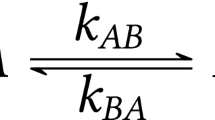Abstract
Anisotropy of the molecular magnetic susceptibility gives rise to a small degree of alignment. The resulting residual dipolar couplings, which can now be measured with the advent of higher magnetic fields in NMR, contain information on the orientation of the internuclear vectors relative to the molecular magnetic susceptibility tensor, thereby providing information on long range order that is not accessible by any of the solution NMR parameters currently used in structure determination. Thus, the dipolar couplings constitute unique and powerful restraints in determining the structures of magnetically oriented macromolecules in solution. The method is demonstrated on a complex of the DNA-binding domain of the transcription factor GATA-1 with a 16 base pair oligodeoxyribonucleotide.
This is a preview of subscription content, access via your institution
Access options
Subscribe to this journal
Receive 12 print issues and online access
$189.00 per year
only $15.75 per issue
Buy this article
- Purchase on Springer Link
- Instant access to full article PDF
Prices may be subject to local taxes which are calculated during checkout
Similar content being viewed by others
References
Wüthrich, K. NMR of Proteins and Nucleic Acids (Wiley, New York; 1986).
Clore, G.M. & Gronenborn, A.M. Determination of three-dimensional structures of proteins and nucleic acids in solution by nuclear magnetic resonance spectroscopy. CRC Crit. Rev. Biochem. Mol. Biol. 24, 479–564 (1989).
Tjandra, N., Garrett, D.S., Gronenborn, A.M., Bax, A. & Clore, G.M. Defining long range order in NMR structure determination from the dependence of heteronuclear relaxation times on rotational diffusion anisotropy. Nature Struct. Biol. 4, 443–449 (1997).
Gayathri, C., Bothner-By, A.A., van Zijl, P.C. M. & MacLean, C., Dipolar magnetic field effects in NMR spectra of liquids. Chem. Phys. Lett. 87, 192–196 (1982).
Bothner-By, A.A. Magnetic field induced alignment of molecules. In Encyclopedia of Nuclear Magnetic Resonance (eds Grant, D. M. & Harris, R.K.) 2932–2938 (Wiley, Chichester; 1995).
Tolman, J.R. & Prestegard, J.H. A quantitative J-correlation experiment for the accurate measurement of one-bond amide 15N–1H couplings in proteins. J. Magn. Reson. B 112, 245–252 (1996).
Tjandra, N., Grzesiek, S. & Bax, A. Magnetic field dependence of nitrogen-proton J splittings in 15N-enriched human ubiquitin resulting from relaxation interference and residual dipolar coupling. J. Am. Chem. Soc. 118, 6264–6272 (1996).
Tjandra, N. & Bax, A. Measurement of dipolar contributions to 1JCH splittings from magnetic field dependence of J modulation in two-dimensional NMR spectra. J. Magn. Reson. 124, 512–515 (1997).
Tolman, J.R., Flanagan, J.M., Kennedy, M.A. & Prestegard, J.H. Nuclear magnetic dipole interactions in field-oriented proteins: Information for structure determination in solution. Proc. Natl. Acad. Sci. U.S.A. 92, 9279–9283 (1995).
Tolman, J.R., Flanagan, J.M., Kennedy, M.A. & Prestegard, J.H. NMR evidence for slow collective motions in cyanometmyoglobin. Nature Struct Biol. 4, 292–297 (1997).
Tjandra, N. & Bax, A. Are proteins even floppier than we thought? Nature Struct. Biol. 4, 254–256 (1997).
Lipari, G. & Szabo, A. Model-free approach to the interpretation of nuclear magnetic resonance relaxation in macromolecules I: theory and range of validity. J. Am. Chem. Soc. 104, 4546–4559 (1982).
Sanders, C.R., Hare, B.J., Howard, K.P. & Prestegard, J.H. Magnetically-oriented phospholipid micelles as a tool for the study of membrane-associated molecules. Prog. Nucl. Magn. Reson. Spectrosc. 26, 421–444 (1994).
Salvatore, B.A., Ghose, R. & Prestegard, J.H. NMR studies of a 13C,15N-labeled GM4-lactam glycolipid at an oriented model-membrane interface J. Am. Chem. Soc. 118, 4001–4008 (1996).
Werbelow, L.G. in Encyclopedia of Nuclear Magnetic Resonance (eds Grant, D. M. & Harris, R.K.) 4072 (Wiley, Chichester; 1995).
Kung, H.C., Wang, K.Y., Goljer, I. & Bolton, P.H. Magnetic alignment of duplex and quadruplex DNAs. J. Magn. Reson. Ser. B, 109, 323–325 (1995).
Omichinski, J.G., Clore, G.M., Schaad, O., Felsenfeld, G., Trainor, C., Appella, E., Stahl, S.J., Gronenborn, A.M. NMR structure of a specific DNA complex of a Zn-containing DNA binding domain of GATA-1 Science 261, 438–446 (1993).
Nilges, M., Gronenborn, A.M., Brünger, A.T. & Clore, G.M. Determination of three-dimensional structures of proteins by simulated annealing with interproton distance restraints: application to crambin, potato carboxypeptidase inhibitor and barley serine proteinase inhibitor 2. Protein Engng. 2, 27–38 (1988).
Metzler, W.J., Wittekind, M., Goldfarb, V., Mueller, L. & Farmer, B.T. Incorporation of 1H/13C/15N-{lle, Leu, Val} into a perdeuterated protein: Potential in structure determination of large proteins by NMR. J. Am. Chem. Soc. 118, 6800–6801 (1996).
Gardner, K.H., Rosen, M.K. & L.E. Kay, Global folds of highly deuterated, methyl-protonated proteins by multi-dimensional NMR. Biochemistry 36, 1389–1401 (1997).
Brünger, A.T. XPLOR Manual Version 3.1 (New Haven, Connecticut: Yale University; 1993).
Laskowski, R.A., MacArthur, M.W., Moss, D.S. & Thornton, J.M. PROCHECK: a program to check the stereochemical quality of protein structures. J. Appl. Crystallogr. 26, 283–291 (1993).
Author information
Authors and Affiliations
Corresponding authors
Rights and permissions
About this article
Cite this article
Tjandra, N., Omichinski, J., Gronenborn, A. et al. Use of dipolar 1H–15N and 1H–13C couplings in the structure determination of magnetically oriented macromolecules in solution. Nat Struct Mol Biol 4, 732–738 (1997). https://doi.org/10.1038/nsb0997-732
Received:
Accepted:
Issue Date:
DOI: https://doi.org/10.1038/nsb0997-732



